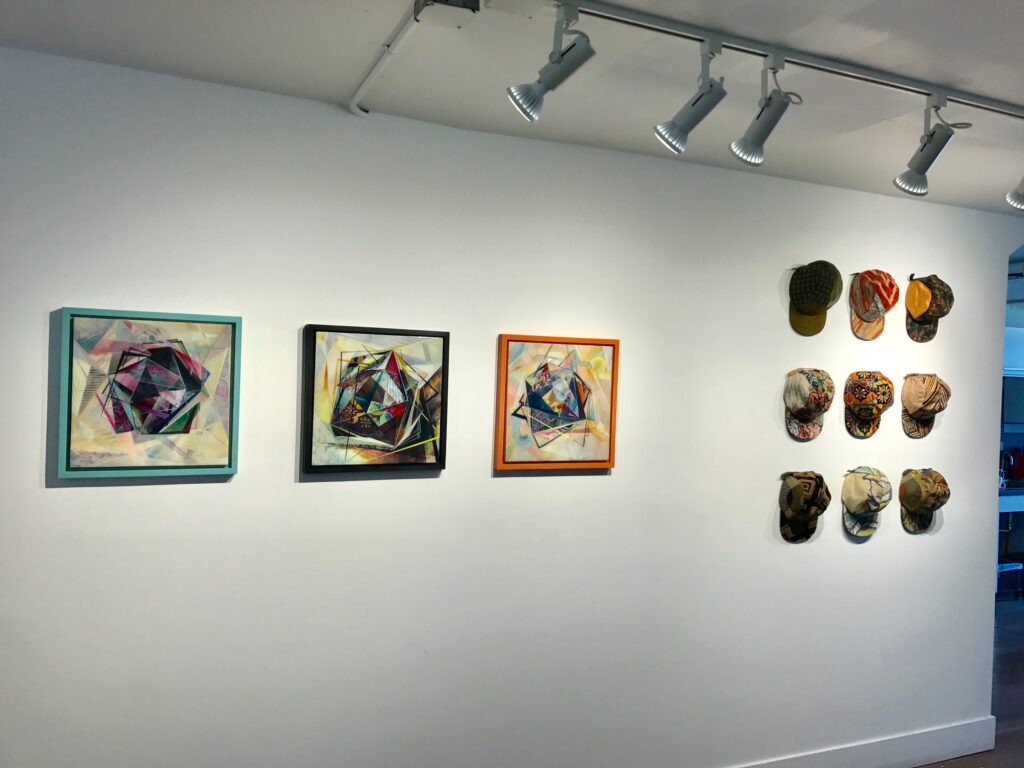
Root Division Studio Artist, Paula Lucia is fascinated by the balance between opposing forces within abstraction. Her two-dimensional work creates space that is both flat and layered; color that is simultaneously harmonious and unbalanced; and imagery that is graphic and abstracted. Lucia’s paintings form swirling worlds of geometric shapes in which the viewer is transported to a new, window-like realm — only to then be pushed out again.
For her recent installation, Oscillating Oppositions, Lucia has developed a clear, reciprocal relationship between her paintings and brand of handmade snapback hats. Lucia’s approach to reclaimed materials is utilized through both collage within her paintings and as re-purposed fabric for her hats. Exhibited alongside one another in the Frank Ratchye Project Space, her individualized hats take on new meaning as singular objects – pushing forward Lucia’s commitment to wearable art.
Exhibitions Fellow, Samantha Reynolds meets with Lucia to discuss her current installation in the Frank-Ratyche Project Space on view from August 30 – September 30, 2017.
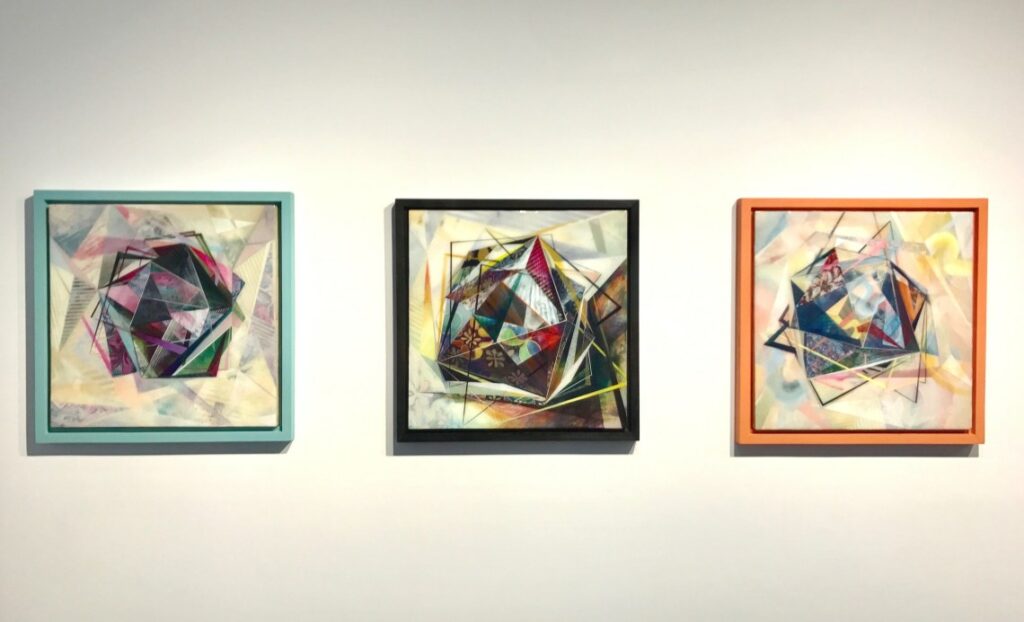
Samantha Reynolds: Currently, you have two bodies of work: geometric, abstract paintings and snapback hats. Are these two creative outputs in constant dialogue? How do they inform one another?
Paula Lucia: For about a month or so, I work intensely doing nothing but sewing to make a number of hats, and I then switch to refocus on painting. I repeatedly go back and forth in this way. These mediums require such different mental spaces and technicality. They are constantly oscillating in my practice.
SR: I love this concept of oscillation. How do you find the balance between these two approaches to making?
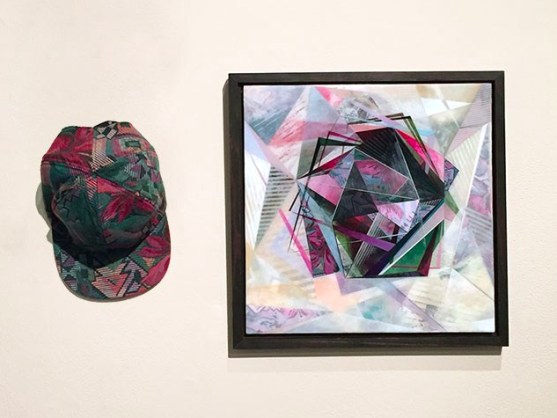
PL: Painting can feel like a struggle — making constant aesthetic decisions on composition. The end product for me is unknown and finding it can be a taxing process. In contrast, making hats feels mathematical similar to a systematic execution. After painting, sewing is a cerebral relief, but it also demands an intense level of focus, which then leads me right back to painting.
The reprieve from each practice gives me time to figure out what is next. There is always an adjustment or pivot between periods of working with each medium and in that way they indirectly inform one another.
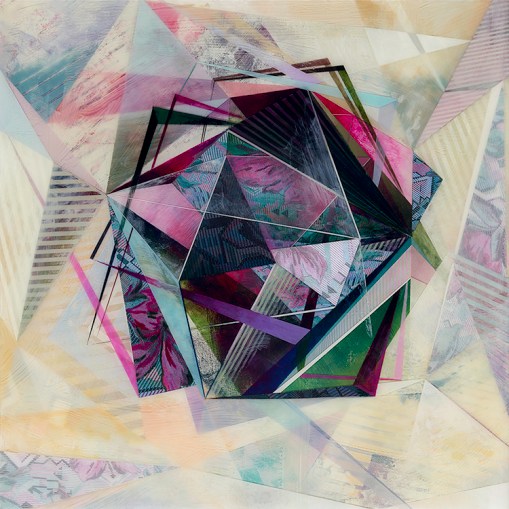
SR: The first thing I notice when I walk into your studio are the strips and piles of various fabrics. What is your process of collecting? Do you search out for a certain type of material? Do certain contrasts in pattern and seemingly unnatural color combinations appeal to you?
PL: Sewing is a practice I hold dearly. I was taught by my mother at a young age and my relationship to fabric stems from that. It is all very personal and earnest. Most of the fabric I have in my studio is found, second-hand scrap, which I prefer over buying by the yard.
I only have a limited supply of each textile, which makes it feel like a collection. I develop strong attachments to different fabrics. I am especially connected to the materials that I find second-hand that feel as if they are associated to a specific individual and less manufactured.
I am also drawn to upholstery thick fabrics, particularly ones that have interesting tactile qualities. The seemingly unnatural color combinations are really just my style. I don’t want anything to feel too predictable or easy. The combination of fabrics and colors inside and outside the hats are what make them unique and stand out from one another.
SR: Are these fabrics then incorporated into your paintings?
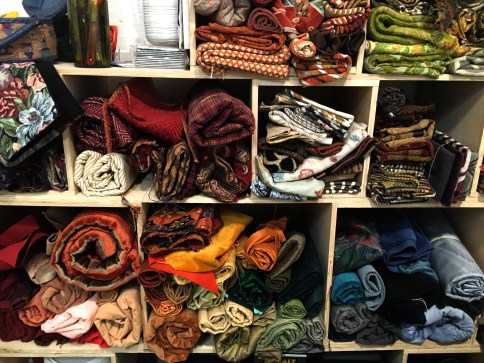
PL: Right now, I am distorting the fabric patterns into my paintings. I feel an authentic connection with these fabrics and incorporating textile patterns in my paintings as if I am placing a bit of myself into seemingly, non-objective abstraction.
SR: What interests you most about snapback hats as an object?
PL: As an object, snapback hats are very sculptural – combining two-dimensional visual elements to create a three-dimensional form. Placed on the wall, the viewer can only see the exterior of the form, but the inside of the hats is what I find almost more interesting. I combine tape, sweatbands, and miscellaneous fabrics under the hat brim. This combination of materials feels much more complex.
I spend a substantial amount of time picking out the colors and fabrics for the interiors of my hats to complement and slightly contradict the exteriors.
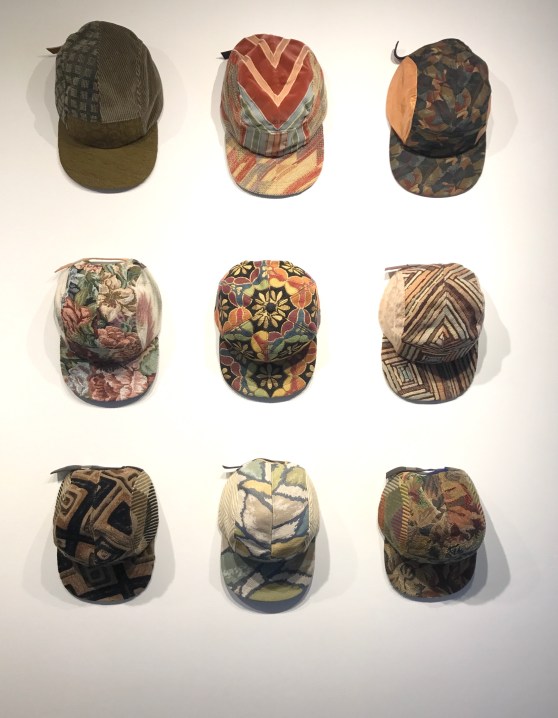
SR: For your installation in the Frank Ratchye Project Space, the hats operate as individual works in their own right. How does this add to your interest in creating “wearable” art?
PL: Previously my sewing practice consisted of making articles of clothing for myself – shirts, dresses, swimsuits. Hats feel more universal and in that way I think more purely a reflection of the self. For someone to wear such a unique article of clothing so boldly on their head, it can become a reflection of who that person is or how they want to be viewed. To me, the hats are really about being an individual.
SR: What are a few of your hopes that the viewer can take away from your installation?
PL: I hope the viewer has two different experiences with the work to acknowledge both the object-ness and wearable quality of the hats. As apparel, I see the viewer evaluating and aligning with one or more hats – that the grid becomes options that are further or closer to that individual’s taste or self.
I hope the installation confronts the viewer with the question of how to perceive the work as an art object, as an article of clothing, or as both.
